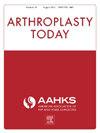运动学对齐全膝关节置换术中屈曲矢状位稳定性:单半径后稳定和髁稳定假体的定量放射学松弛研究
IF 2.1
Q3 ORTHOPEDICS
引用次数: 0
摘要
背景:在全膝关节置换术(TKA)中,完全伸展和90°屈曲之间的稳定性对成功的结果至关重要。因此,我们通过一项随机的前瞻性研究,比较了单桡骨髁稳定(CS)与后稳定(PS)装置植入膝关节的矢状位/前后位(AP)稳定性。我们假设具有优越矢状面/AP稳定性的种植体组将表现出更好的临床结果。方法65例患者采用PS装置(28例)或CS装置(37例)行原发性TKA。术后5-7年收集的结果包括膝关节学会(KS)评分、活动范围(ROM)、下肢活动量表、遗忘关节评分以及机械和解剖对齐。通过应力x线片评估45°和90°屈曲时矢状位/前位稳定性。结果CS组和PS组在tka后的平均时间分别为85.8和77.3个月。CS组表现出更大的平均AP松弛,特别是在45°中屈曲时。对齐、ROM和患者报告的结果评分相似。然而,CS组女性表现出较差的平均KS功能(P = .02)和总综合评分(P <;.01),与PS组相比。这些分数在男性和两组之间没有显著差异。结论两组患者矢状面/AP关节均存在明显的中屈曲松弛。在有限的可用人群中,CS植入患者观察到的更大的松弛并不对应于遗忘关节评分、下肢活动量表、ROM或对齐的差异;然而,在女性中,KS功能和总综合评分之间的差异揭示了矢状松弛与临床结果之间的反比关系。证据水平。本文章由计算机程序翻译,如有差异,请以英文原文为准。
Mid-Flexion Sagittal Stability of Total Knee Arthroplasty Implanted With Kinematic Alignment: A Quantitative Radiographic Laxity Study With Single-Radius Posterior-Stabilized and Condylar-Stabilized Implants
Background
Stability between full extension and 90° of flexion is crucial for successful outcomes in total knee arthroplasty (TKA). Thus, we compared the sagittal/anteroposterior (AP) stability of knees implanted with single-radius condylar-stabilized (CS) vs posterior-stabilized (PS) devices from a randomized, prospective study. We hypothesized that the implant group with superior sagittal/AP stability would exhibit better clinical outcomes.
Methods
Sixty-five patients underwent primary TKA with a PS (n = 28) or CS (n = 37) device. Outcomes collected 5-7 years postoperatively included Knee Society (KS) Scores, range of motion (ROM), the Lower Extremity Activity Scale, the Forgotten Joint Score, and mechanical and anatomic alignment. Sagittal/AP stability was evaluated in 45° and 90° of flexion via stress radiographs.
Results
The CS and PS groups averaged 85.8 and 77.3 months post-TKA, respectively, at evaluation. The CS group demonstrated greater mean AP laxity, especially in 45° mid-flexion. Alignment, ROM, and patient-reported outcome scores were similar. However, women in the CS group demonstrated inferior mean KS Function (P = .02) and Total Composite scores (P < .01) compared to women in the PS group. These scores were not significantly different for men or the combined groups.
Conclusions
Mid-flexion sagittal/AP laxity was substantial in both implant groups. With the limited population available, the greater laxity observed in patients with CS implants did not correspond to differences in Forgotten Joint Score, Lower Extremity Activity Scale, ROM, or alignment; however, the difference between the KS Function and Total Composite scores in women revealed an inverse relationship between sagittal laxity and clinical outcomes.
Level of evidence
I.
求助全文
通过发布文献求助,成功后即可免费获取论文全文。
去求助
来源期刊

Arthroplasty Today
Medicine-Surgery
CiteScore
2.90
自引率
0.00%
发文量
258
审稿时长
40 weeks
期刊介绍:
Arthroplasty Today is a companion journal to the Journal of Arthroplasty. The journal Arthroplasty Today brings together the clinical and scientific foundations for joint replacement of the hip and knee in an open-access, online format. Arthroplasty Today solicits manuscripts of the highest quality from all areas of scientific endeavor that relate to joint replacement or the treatment of its complications, including those dealing with patient outcomes, economic and policy issues, prosthetic design, biomechanics, biomaterials, and biologic response to arthroplasty. The journal focuses on case reports. It is the purpose of Arthroplasty Today to present material to practicing orthopaedic surgeons that will keep them abreast of developments in the field, prove useful in the care of patients, and aid in understanding the scientific foundation of this subspecialty area of joint replacement. The international members of the Editorial Board provide a worldwide perspective for the journal''s area of interest. Their participation ensures that each issue of Arthroplasty Today provides the reader with timely, peer-reviewed articles of the highest quality.
 求助内容:
求助内容: 应助结果提醒方式:
应助结果提醒方式:


